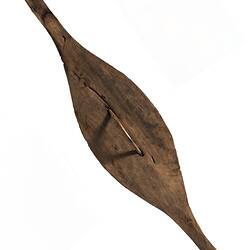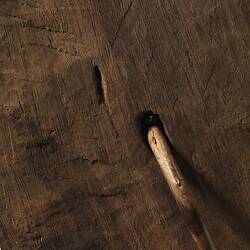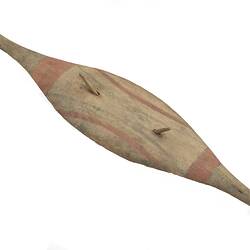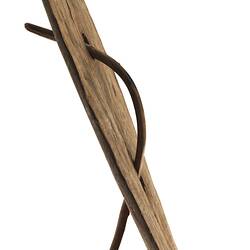Summary
This kanggonayn (broad shield) was made from green bark cut from a eucalyptus tree. It is oval and slightly convex in shape, with a small handle attached. The design on the face of the shield has been created by a pattern of fine engraved lines and light-red ochre bands.
A stone axe would have been used to cut the outline of the shield in the tree, to the shape and size needed; it would then have been removed with a mallet made from wood. This process leaves a scar on the tree in the shape of a shield and many of these trees remain as significant sites throughout the country.
The craftsman would make a mound of earth to match the size of the shield, on top of which he would place hot ashes. The piece of bark would be placed on this and covered with heavy stones and earth. By the time the ashes cooled, the bark would have adopted the shape of the curve of the mound. The handle is formed from a separate piece of green wood that is forced into the two holes cut in the shield; once dried, it is very difficult to remove.
Local Name
Kanggonayn
Physical Description
This broad flat wooden spear shield with long narrow ends has been carved out of wood and decorated with incising and painting. The shield has a handle constructed from a bent branch which is pushed through two holes at the centre of the piece. The decoration consists of scalelike incisions on the ends, diamond shaped incisions at either end of the central section and four curved rows of straight linear incisions in the central part of the shield. There are two curved and two straight red panels.
Significance
The Gunditjmara continue to have a strong social, cultural, and land management presence as the recognised Traditional Owners of a large area of western Victoria. Aquaculture forms an integral part of their ancestral and contemporary identity and subsistence. The Gunditjmara people have continually fought for rights to their traditional country, winning landmark legal cases in both the 1980s and 2007.
Elder Aunty Iris Lovett Gardiner of the Kerrupjamara clan of the Gunditjmara peoples of Lake Condah explains the importance of the marks left in trees all over the lands of her peoples by the manufacture of cultural items made from wood;
'Now we had a lore which came down from the tribal Elders. We were spiritual people. If we saw a tree where the bark had been cut out to make a canoe, that represented to us the spirituality, and that represented to us that our grandfathers and grandmothers were here and left us these things to keep as a sight to see and to be sacred within ourselves.'
Aunty Iris Lovett-Gardiner 2010
Reference:Keeler, C. and Couzens, V., (eds) 2010, Meerreenng-An. This is my Country: The Story of Aboriginal Victoria Told Through Art, Melbourne Koorie Heritage Trust. BPA Print Group, Page 37
More Information
-
Object/Medium
Shield
-
Maker
-
Cultural Groups
-
Locality
-
Date Produced
-
Object Measurements
750 mm (Length), 190 mm (Width), 80 mm (Height)
-
Classification
-
Date Made
-
Maker
-
Clan/Language Group
-
Place Made
-
Indigenous Region
-
Keywords
-
Collection Names
-
Type of item
-
Discipline
-
Category
-
Collecting Areas








